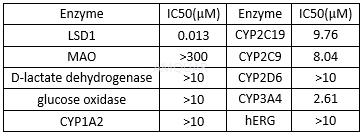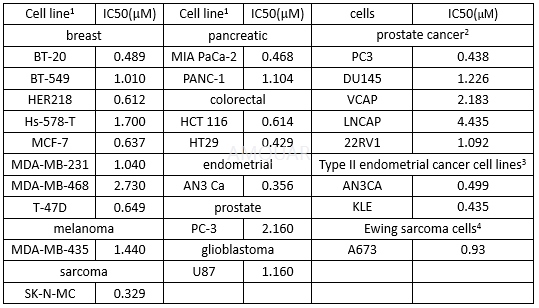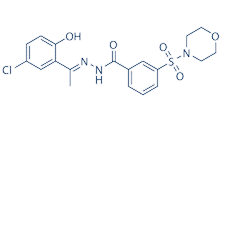-
生物活性
SP2509 is a potent, reversible, selective,FAD-binding pocket noncompetitive LSD1 inhibitor with demonstrated preclinicalefficacy in Ewing’s sarcoma, acute myeloid leukemia and endometrial cancer. SP2509 is a novel histone demethylase LSD1 (KDM1A) antagonist with IC50 of 13 nM; no inhibition on MAO-A and MAO-B. SP2509 attenuated the binding of LSD1 with the corepressor CoREST, increased the permissive H3K4Me3 mark on the target gene promoters, and increased the levels of p21, p27 and CCAAT/enhancer binding protein α in cultured AML cells. In addition, SP2509 treatment or LSD1 shRNA inhibited the colony growth of AML cells. SP2509 also induced morphological features of differentiation in the cultured and primary AML blasts. SP2509 induced more apoptosis of AML cells expressing mutant NPM1 than mixed-lineage leukemia fusion oncoproteins.
Enzymeactivities of SP2509[1]

Cytotoxicity and cell viability of HCI-2509

-
体外研究
-
体内研究
-
激酶实验
SP2509 activity assays[5]
The LSD1 screening biochemical assay kitwas used. SP2509 were diluted to 20 x the desired test concentration in 100%dimethyl sulfoxide and 2.5μl of the diluted drug sample was added to a black 384-well plate.The LSD1 enzyme stock was diluted 17-fold with assay buffer and 40μlof the diluted LSD1 enzyme was added to the appropriate wells. Substrate,consisting of horseradish peroxidase, dimethyl K4 peptide corresponding to thefirst 21 amino acids of the N-terminal tail of histone H3, and10-acetyl-3,7-dihydroxyphenoxazine was then added to wells. Resorufin wasanalyzed on an Envision plate reader with an excitation wavelength of 530nm andan emission wavelength of 595 nm.
The activity of SP2509 on the otheroxidases was determined by using commercially available kits. For determiningthe glucose oxidase activity (which also noncovalently binds FAD in an elongateconformation), the glucose oxidase kit used was procured from Life Technologies.The MAO assays were performed using the MAO-glo kit with MAO-A from Promega andMAO-B from Sigma.

-
细胞实验
XTT cell proliferation assay[6]
Daoy and D283 Med cells were used. ONS-76cells were cultured in RPMI medium 1640 supplemented with 10% FBS, 50 U/mL penicillin,and 50 mg/mL streptomycin. All medulloblastoma cell lines were kept in anincubator at 37oC in a 5% CO2/5% O2/90% N2 atmosphere with maximum humidity. XTT assays were performed in triplicates (n=3)with three replicates for each using 1 x 103 Daoy cells/well, 4 x103 D283 Med cells/well, and 1 x 103 ONS-76 cells/well in 100 mL ofmedium at initial seeding in 96-well plates. These numbers of cells could becultured for 4 days without changing the medium to prevent cell loss due tohandling. In particular, Daoy cells and D283 Med cells were seeded in 3–9replicates and cultured overnight in standard medium. The next day, inhibitorswere added to the cell culture media at appropriate concentrations. Three dayslater, the cells were subjected to XTT viability assays according to the manufacturer’sinstructions. Absorbance values at 475 nm and 660 nm were measured using aFlexStation 3 microplate reader or an EnSpire Multimode Reader 2300, and themedium alone values were subtracted from each. The assay was repeated3–6 timesfor each cell line and for each inhibitor concentration series. To analyze thecells cultured at 21% oxygen, the XTT assays were repeated twice with 3–9replicates plated for each assay.

-
动物实验
Xenograft studies[2]
Sample size calculation accounted for anattrition rate of 10%. The power calculation was based on a two-tailed test ofsignificance with a type I error of 0.05 and a 0.9 probability of detecting atrue difference. This yielded a sample size of 10 animals per arm.
Five million PC3 cells were suspended in50% media (RPMI) and 50% Matrigel, and then implanted in the right hind flankof female nude mice. Animals bearing tumors of adequate size (100 mm3)were randomized based on size into three cohorts of 10 animals each and dosedwith either vehicle intraperitoneally (Monday, Wednesday and Friday), 40mg/kgHCI-2509 intraperitoneally (Monday, Wednesday and Friday) or 40mg/ kg HCI-2509orally (per os) (daily, Monday through Friday) for 3 weeks (last dose administeredon Day 19). Body weight and tumor volume were measured twice weekly. Blood cellcounts (hematocrit, platelet and white blood cell) were measured on days 1 and24 using a HemaTrue Hematology Analyzer.

-
不同实验动物依据体表面积的等效剂量转换表(数据来源于FDA指南)
|  动物 A (mg/kg) = 动物 B (mg/kg)×动物 B的Km系数/动物 A的Km系数 |
|
例如,已知某工具药用于小鼠的剂量为88 mg/kg , 则用于大鼠的剂量换算方法:将88 mg/kg 乘以小鼠的Km系数(3),再除以大鼠的Km系数(6),得到该药物用于大鼠的等效剂量44 mg/kg。
-
参考文献
[1] Sorna V, Theisen ER, Stephens B, et al. High-throughput virtual screening identifies novel N'-(1-phenylethylidene)-benzohydrazides as potent, specific, and reversible LSD1 inhibitors. J Med Chem. 2013;56(23):9496-9508.
[2] Gupta S, Weston A, Bearrs J, et al. Reversible lysine-specific demethylase 1 antagonist HCI-2509 inhibits growth and decreases c-MYC in castration- and docetaxel-resistant prostate cancer cells. Prostate Cancer Prostatic Dis. 2016;19(4):349-357.
[3] Theisen ER GS, Bearss J, Sorna V, Sharma S, Janat-Amsbury M. Reversible inhibition of lysine specific demethylase 1 is a novel anti-tumor strategy for poorly differentiated endometrial carcinoma. BMC Cancer. . 2014;14:752.
[more]
分子式
C19H20ClN3O5S |
分子量
437.91 |
CAS号
1423715-09-6 |
储存方式
﹣20 ℃冷藏长期储存。冰袋运输 |
溶剂(常温)
|
DMSO
46 mg/mL |
Water
<1 mg/mL |
Ethanol
<1 mg/mL |
体内溶解度
-
Clinical Trial Information ( data from http://clinicaltrials.gov )
注:以上所有数据均来自公开文献,并不保证对所有实验均有效,数据仅供参考。
-
相关化合物库
-
使用AMQUAR产品发表文献后请联系我们






















